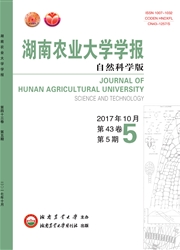

 中文摘要:
中文摘要:
以3年生幼龄柠檬果树为材料,研究轻剪、机剪、重剪3种修剪方式对幼龄柠檬果树产量和效益的影响。结果表明:轻剪、机剪、重剪的春花果总产量依次减少,轻剪、重剪、机剪的春花果总效益依次降低;不同修剪方式对柠檬夏花果总效益和夏花果产量的影响一致,夏花果总效益和优质果效益及夏花果产量的排序结果均为轻剪、机剪、重剪依次降低;春花果和夏花果优质果率排序结果均为轻剪、重剪、机剪依次减小;修剪成本的排序结果为重剪、轻剪、机剪依次减小;总效益的排序结果为轻剪、机剪、重剪依次减小。综合比较,轻剪不仅产量高,综合效益也最好,重剪严重影响第一年的产量。建议在条件具备的情况下优先采用轻剪方式。
 英文摘要:
英文摘要:
Young lemon (Citrus limon (L.) Burm. E) tree with three year old was employed for researching the effects of different pruning modes (light thinning pruning, machinery pruning, heavy pruning) on the fruit yield and its economic benefit. The results showed that the fruit yield of spring-flowering lemon depended on pruning modes, from high to low, the order was light thinning pruning, machinery pruning and heavy pruning, and the economic benefit decreased from light thinning pruning, heavy pruning to machinery pruning in ttLrn. The fruit yield and economic benefit of spring-flowering lemon were consistent. The economic benefits of spring-flowering lemon and the fine-fruit lemon were both declined from light thinning pruning, machinery pruning, to heavy pruning in turn, and the cost of pruning were followed on the order of heavy pruning, light thinning pruning, and machinery pruning. The total benefit was ordered by light thinning pruning, machinery pruning and heavy pruning. From the view of fruit yieJd and economic benefit, light thinning pruning, as a recommended mode, was the best one, while heavy pruning could seriously influence the fruit yield in the first year.
 同期刊论文项目
同期刊论文项目
 同项目期刊论文
同项目期刊论文
 期刊信息
期刊信息
